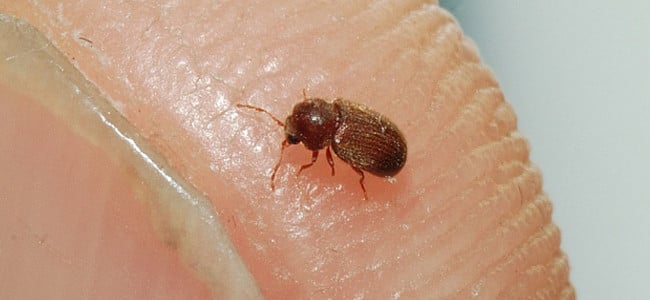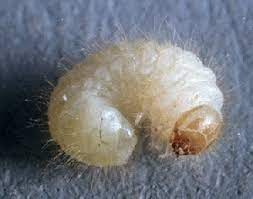Drugstore beetles often go unnoticed until the infestations gets large.
This is because they are small and often hide inside package or dry foods. This makes them hard to identify and by the time you do, they will have infested so much of your food or kitchen.
So how do you identify and get rid of these little pests?
I’ve got you covered. In this post, I will go over how to identify a drugstore beetle infestation and how to get rid of them with six easy steps.
Drugstore Beetle Identification
What Do Drugstore Beetles Look Like?

Drugstore beetles are a common pantry pest.
These beetles only grow between 1/10 and 1/8 inches long. The drugstore beetles have a small cylindrical body that is a reddish-brown, almost light burgundy color.
Drugstore beetles also have distinct vertical lines going down their wings. These lines nearly look like ridges on the wings.
These vertical lines are often used to differentiate drugstore beetles from similar pantry beetles like the cigarette beetle.
What Do Drugstore Beetle Larvae Look Like?

Drugstore Beetle larvae look very similar to maggots. They are small white or cream-colored grubs that only grow to be about 1/8 inch long.
They will often leave small holes on the surfaces of the food they infest. These holes are so small they often go unnoticed. One way to identify the holes is by how uniform and perfect of an entry hole they leave behind.
What Do Drugstore Beetles Eat?
Drugstore beetles eat a variety of foods and eating almost anything they can get their hands on.
This includes
- stored foods,
- Seeds
- Nuts
- Pet foods
- Spices
- Flour
- Dry foods
- Cereal
- Grains
Essentially anything that is stored outside, not in the fridge, and not a liquid they will attempt to eat.
This makes them very problematic because they will infest anything and everything inside your kitchen if they have a chance.
Inside your home they are commonly found inside dry food containers that are easily accessible.
This typically includes food stores in thin bags or thin cardboard boxes such as flour, cereal, pet food, spiders, or grains.
Signs of Drugstore Beetles
Identifying drugstore beetle infestations are difficult if you don’t know what you’re looking for.
There are some key signs that you can look for to help you identify these sneaky little pests.
Below are some things you can look for:
- Adult drugstore beetles flying around
- Small holes on food or packages
- Debris or frass around infested items
- larva inside dry food
- small clusters of eggs under or behind objects
When looking for signs of drugstore beetles, you should use a flashlight and a magnifying glass to help you spot them.
A flashlight and a magnifying glass can make the difference between finding the infestation and missing it completely.
How To Get Rid of Drugstore Beetles
1. Inspect Kitchen, Pantry, and Any Food Containers
The first thing you want to do if you suspect that you have drugstore beetles is to inspect your pantry and kitchen.
Kitchens and pantries are the most common place you will find drugstore beetles.
They commonly hide inside food packages or food containers. Any containers or bags of food are vulnerable to a drugstore beetle infestation.
You want to empty your pantry or anywhere you store food and inspect any open food. You also want to inspect any food stored in bags or boxes.
The larva can eat their way through the plastic and thin cardboard boxes. These entry points won’t be noticeable so it’s important that you open all the items in your pantry and inspect them thoroughly.
Eggs, larva, and cocoons can be found inside pantry liners, on boxes, and behind jars and other containers.
Any containers that contain signs of beetles should be thrown away.
2. Place Food inside Airtight containers
All dry food should be placed in airtight containers. Airtight containers will keep your food safe from drugstore beetles.
Drugstore beetles or their larvae can’t enter through plastic or glass airtight containers.
Not only will it keep your food safe, it will also keep your food fresh for longer.
To ensure the effectiveness of your airtight containers, you must always make your properly close your containers.
If not closed properly, you leave your food susceptible to drugstore beetles.
Even if there is still an infestation in your pantry, the airtight containers will keep your food safe.
Before placing your food inside airtight containers, inspect your food to ensure there is no infestation inside.
3. Clean or Replace Shelf liners
Shelf liners are one of the primary areas where drugstore beetles tend to hide and lay their eggs.
One reason for this is that it provides shelter and protection.
Another reason is that food and moisture tend to accumulate on the liners giving the beetles a food source.
Pantry liners are key spots that you can find eggs, pupa, and larvae.
They are especially susceptible when they are moist or water-damaged.
This makes it ideal for drugstore beetles to survive.
If you have reusable or washable panty liners, you can wash them with hot water and bleach. I recommend running them on the high heat setting of the dishwasher with bleach.
This will make sure that you kill any eggs, larvae, or adult moths.
If your liners are damaged, I recommend replacing them. Pantry liners are relatively cheap, making it inexpensive to replace all the pantry liners in your home.
4. Dispose of Infested Food
Any food that is not stored in airtight containers should be disposed of. Food that is not inside airtight containers could be infested with drugstore beetle larva.
Since drugstore beetles are hard to spot in large quantities of dry food, it might be better to dispose of them.
While eating these beetles won’t cause much harm, it will make most people’s skin crawl to know that there is insect larva inside their food.
Any food stored in zip lock bags, paper bags, or thin plastic should be disposed of properly.
Only food stored in airtight containers, glass containers, or thick cardboard can be kept.
Any other food should be disposed of unless you are certain there are no pantry moths inside.
5. use Traps
Traps are one of the most effective options you can use to get rid of drugstore beetles.
You can purchase a pheromone trap or use a sticky moth trap to capture these beetles.
The great thing about these traps is that they should work on both adults and larvae.
You want to place these traps inside your pantry, kitchen, or any other places you suspect drugstore beetles inside your home.
You want to place them in locations where they are likely to hide. This will make the traps more effective.
You can also use these traps as a way to monitor your infestation.
If the traps are still experiencing heavy amounts of traffic, then you still have a moth problem. When the traps start experiencing less activity, then this is a sign that you have reduced the source.
6. Clean Frequently and Thoroughly
You want to make sure that you clean your kitchen and pantry areas thoroughly and frequently.
This includes shelves, airtight containers, and any other containers that can be easily cleaned.
One of the best natural ways to clean your pantry includes a mixture using:
- Hot Water
- Vinegar
- Essential Oil
This combination is effective at eliminating bacteria as well as adding a repellency effect. The strong scent tends to drive drugstore beetles away.
As an alternative, you can also use a one-to-one ratio of bleach and water.
Be sure to spray all areas thoroughly and wide down all surfaces once you are complete.
I recommend using a spray bottle and a microfiber cloth to make sure that you clean every part of your kitchen.
Pro Tip: Don’t Use Insecticides
Avoid using pesticides where you store or cook your food. Unfortunately, in most cases, this is where drugstore beetles hide.
Spraying toxic pesticides near your food is dangerous—especially those with residual effects.
This means that even if you touch the pesticide after its application, there will be some chemical residue.
Since your food will be in this area, the risk of ingesting pesticides is too dangerous and should be avoided.
One common pesticide often used mothballs.
While mothballs can kill moths, they are highly toxic to both humans and pets.
Using these in confined areas such as pantries or kitchens can be dangerous.
If you plan to use mothballs, remember to follow the ventilation and coverage directions before apply them inside your home.
Frequently Asked Questions (FAQ)
Are Drugstore Beetles Harmful?
Drugstore beetles are not harmful to humans or pets and are considered a nuisance pest more than anything else.
They are not known to carry or transmit any diseases to humans. Drugstore beetles commonly infest dry food items and leave their larva, urine, and feces behind.
Do Drugstore Beetles Bite?
No, adult and larvae drugstore beetles don’t bite.
Even if these beetles did bite, likely, you wouldn’t feel it because they are so small.
They are not known to transmit or carry diseases, so there is nothing to worry about if they get on you.
What Happens If You Eat a Drugstore Beetle?
It’s completely safe to eat a drugstore beetle. Unfortunately, people accidentally eat drugstore beetle adults, larva, and eggs more often than you would think.
Eating any stage of a drugstore beetle is harmless. They are not known to carry any diseases or carry any harmful bacteria.
If you eat them, nothing will happen, and you won’t feel any different. It’s likely you won’t even notice that you eat the drugstore beetle.
Can Drugstore beetles Infest Bedrooms?
Yes, drugstore beetles can infest bedrooms but it’s unlikely. If you do find them inside your bedroom it likely that they are infesting dried goods inside your bedroom, medication, or some other source of food.
If you find adults flying around your room, it’s possible that they entered your room by accident.
Clean your room and eliminate any potential areas that the drugstore beetles can live.
How Do Drugstore Beetles Get In Your House?
Drugstore beetles typically get into home in one of two ways.
- They fly into your home through an open window or door. Adult drugstore beetles are attracted to light and this attracts them to structures.
- They hitchhike their way into your home inside packaged food from stores or other homes.
Its important that you keep your doors closed or install screens to prevent drugstore beetles from coming inside your home.
Second, you want to inspect any food you bring into your home. Pay special attention to dry foods because drugstore beetles prefer to live and often infest.
